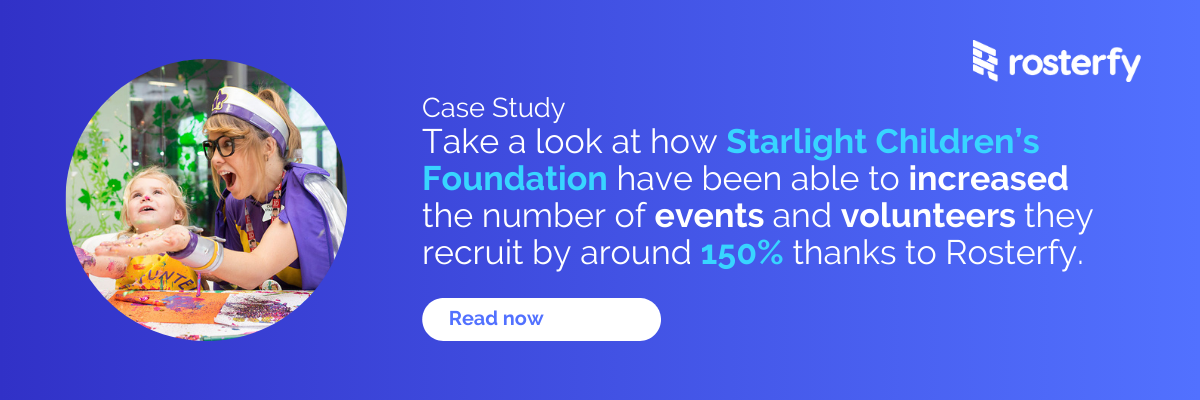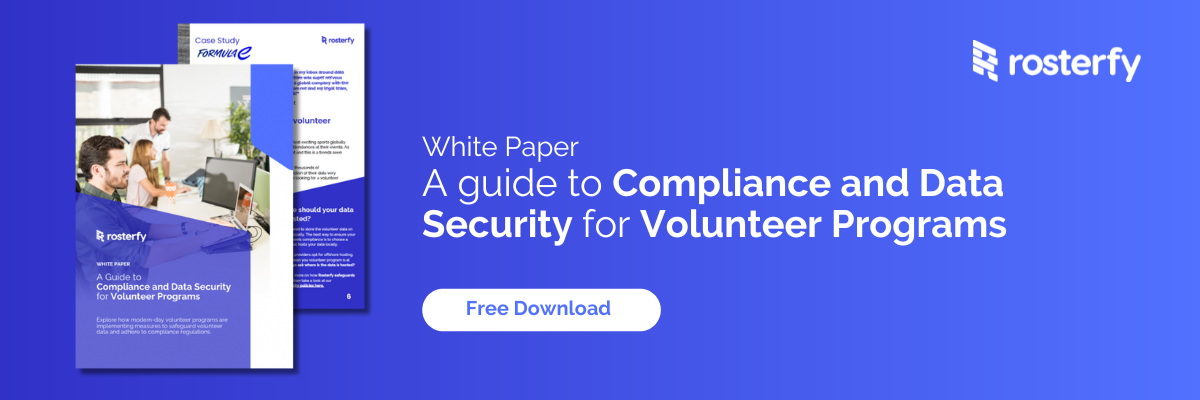Volunteering with children offers unique opportunities to impact young lives positively while enriching the volunteers' experience. Nonprofits, hospitals and sporting federations must manage and screen volunteers effectively to safeguard children and ensure a smooth onboarding process. By implementing streamlined volunteer management practices, organisations can boost volunteer engagement and operational compliance, creating a safe and productive environment for both kids and volunteers.
Properly managed volunteer work amongst children not only supports kids’ developmental needs but also provides a rewarding experience for the volunteers. Improved engagement strategies can lead to better retention and volunteer satisfaction, which is crucial for long-term success. The focus on meticulous screening and onboarding ensures that only the most suitable individuals work closely with children, maintaining the trust of families and communities.
This post aims to equip your organisation with practical strategies to enhance your volunteer management processes to ensure maximum compliance. From screening and interviews to comprehensive onboarding, learn how to create an effective framework that benefits children and volunteers alike, fostering a safe and supportive environment.
Communicating the importance of volunteering with children
Of course, organisations know the benefits of volunteering with children, but it’s important to convey these to your potential volunteers, even more so in a sector where additional background checks might deter those interested in volunteer work from going through the necessary steps to ultimately register as part of your team.
Well-engaged volunteers can not only impact children's lives through mentorship and education, but also help attract additional volunteers through word of mouth to family and friends.
Some volunteers will be motivated by the mental health benefits or a sense of belonging the work offers; others will look to build their problem-solving skills to boost their resume or be part of a bigger mission that creates a positive impact in their community.
Proper onboarding workflows and volunteer profiles can help you understand each individual better to guarantee enriched volunteer experiences that lead to enhanced care for children and higher satisfaction among your organisation.
Effective volunteer management and onboarding have already shown remarkable success. For instance, the Starlight Children's Foundation has managed to create a consistent volunteer experience across country-wide events while increasing the number of recruited volunteers.

Well-structured volunteer programs also enhance a charity’s reputation, attracting more support and resources. Organisations like Literacy Pirates demonstrate how increased visibility and engagement can benefit both children and volunteers while lowering screening costs.
Communicating these points clearly will help in recruiting dedicated volunteers, ensuring that your program is not only effective but also deeply impactful.
Finding and recruiting the right person for each volunteer role
When you are aiming to find the right person for each volunteer role, a well-planned approach is essential. Start by identifying the volunteer requirements, including skills and availability, and craft clear and compelling role descriptions.
Targeted Outreach: Consider collaborating with local organisations, schools and community centres. Platforms such as Seek Volunteer and Volunteering Australia can be effective in reaching additional volunteers. Tailoring your outreach efforts to these audiences can help you attract dedicated and committed individuals.
Effective Advertising: Creating engaging ad campaigns is crucial. Highlight the benefits and responsibilities associated with each volunteer opportunity and make sure your listings are easy to read and convey the impact of the volunteer's work. Use bullet points and bold text to emphasise key aspects.
Leveraging Networks: Utilise your existing networks and partnerships. Encourage word-of-mouth referrals and use social media to spread the word. Existing volunteers can often help in finding new people who share a passion for your cause.
Diverse Recruitment: Promote inclusivity by actively recruiting a diverse volunteer base. Diverse teams bring various perspectives and skills, which can enhance your program's effectiveness. This is particularly important when working with children, as it helps create a richer and more supportive environment.
Make use of resources like neuro inclusion strategies to ensure your recruitment processes are inclusive and effective. By adopting these strategies, you can build a robust team of volunteers dedicated to making a difference.
Creating a safe and compliant environment for volunteers and children
To create a safe and compliant environment for volunteers and children, especially those in foster care or with special needs, adhere to specific guidelines and regulations. This involves regular information sessions, comprehensive training and consistent updates from healthcare professionals.
Working with Children Check (WWCC)
One of the most critical steps in safeguarding children is ensuring all volunteers have the necessary Working With Children Check (WWCC). This check is a legal requirement, with local variations among territories and regions, and helps identify any past criminal behaviour that may disqualify someone from working with children.
Besides the WWCC, some regions may have additional requirements. For instance, the VIT Registration in Victoria for teachers or the Queensland Blue Card. Other organisations may require volunteers to complete a police background check in addition to a WWCC to foster a safe environment. Ensuring compliance with all local regulations helps protect your organisation from legal issues and foster a safer environment for children.
Mandatory reporting and training
Volunteers must be aware of their legal obligations regarding mandatory reporting. This includes recognising signs of abuse or neglect and knowing how to report these issues appropriately. Providing thorough training on these topics ensures that volunteers are prepared to act responsibly.

Streamlining the application and documentation process
Charities can streamline the application and documentation process for volunteers using platforms like Rosterfy. Here are some tips:
- Centralised Database: Use Rosterfy to maintain a centralised database of all volunteer documents, making it easier to track and verify WWCC and other credentials.
- Automated Reminders: Set up automated reminders for when WWCC or other credentials are due for renewal. The system can even be configured to not allow volunteers to apply for a shift without a valid WWCC. This helps ensure that no volunteer is operating with expired documentation.
- Simplified Application Forms: Reduce barriers to entry by simplifying application forms and allowing digital submissions through Rosterfy.
Comprehensive training programs and clear policies
Training and thorough policies are the cornerstone of volunteer preparation. Programs should cover:
- Child Protection: Teach volunteers how to identify and respond to potential risks to children.
- Inclusivity: Ensure volunteers understand and respect diversity, creating an inclusive environment for all children.
- Effective Communication: Train volunteers in communication skills to interact positively with children and other team members.
- Code of Conduct: Outline acceptable and unacceptable behaviours.
- Incident Reporting: Provide clear procedures for reporting and handling incidents.
Rosterfy can track volunteer participation in these training programs, ensuring everyone has completed the necessary preparation.
Keeping up to date
WWCC and other credentials have expiration dates. It’s vital to collect and verify these credentials initially and keep track of their expiries. Rosterfy can automate this process, sending notifications to both volunteers and administrators when renewals are due.
However, it’s important to not just treat this as a bureaucratic act, as volunteers may need support during this phase. This helps your organisation achieve your compliance goals while making them feel confident and valued, knowing they can seek help if needed. Regular check-ins and accessible supervisors can make a big difference.
Feedback mechanisms
Implementing feedback systems allows volunteers to voice their concerns and suggestions. This can be done through:
- Surveys: Regular anonymous surveys to gather honest feedback.
- Open Forums: Scheduled meetings where volunteers can discuss issues in a group setting.
- Direct Channels: Clear communication lines for reporting specific concerns.
However, feedback also works the other way around, as it can give you an opportunity to recognise and reward volunteers. Keeping volunteers informed about the impact of their work and organisational achievements can drive engagement and motivate them to discuss it with friends and family, which can get them interested in your mission.
Make sure to plan for regular acknowledgements of individual and group contributions or to implement programs to reward long-term commitments to unite everyone under the same mission.
By utilising these strategies and tools like Rosterfy, organisations can create a safe, compliant and supportive environment for both volunteers and the children they serve.
Keep your communities safe while ensuring a positive volunteer experience
Creating a safe environment for child patients can feel like a vague and abstract goal, but proper onboarding and volunteer engagement strategies will let you see the path there in no time.
Families deserve to rest assured that their children are in safe hands, and a well-managed program will let your volunteers truly support medical staff to make a difference in their lives.
If you’d like to learn more about how Rosterfy can help achieve those goals, book a demo today and see how your organisation can benefit from its features.